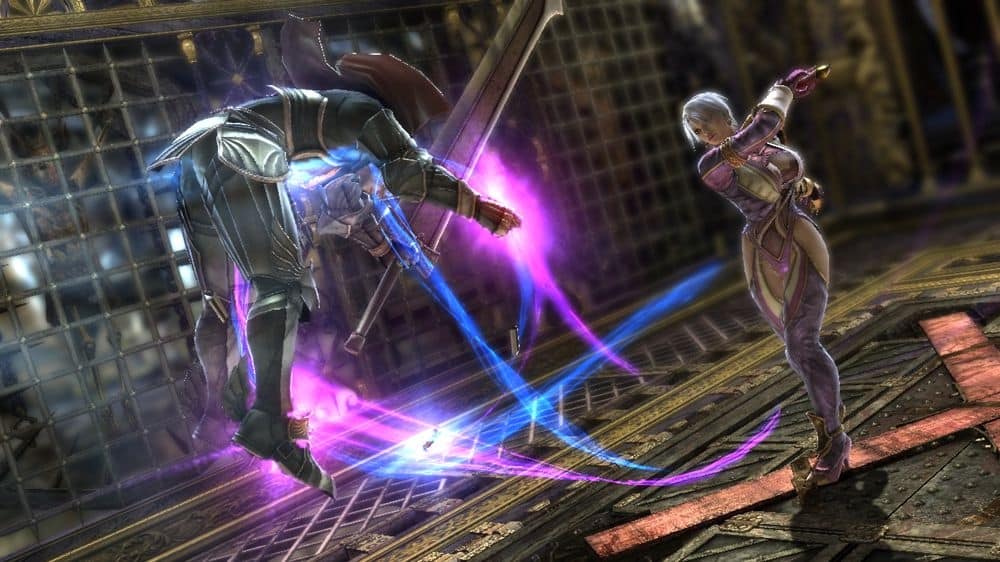You can trust VideoGamer. Our team of gaming experts spend hours testing and reviewing the latest games, to ensure you're reading the most comprehensive guide possible. Rest assured, all imagery and advice is unique and original. Check out how we test and review games here
For a game that boasts to be a tale of soul and swords eternally retold, Soul Calibur IV was a little too soulless. The fifth entry enters the ring embroiled in an identity crisis, then, with SoulCalibur V forced to reinvent a series quickly losing its relevance despite a fighting genre in the midsts of renaissance.
First impressions are positive. Stages burst with colour, and silky animations ensure characters’ attacks flow neatly into one another. The series’ bread-and-butter combos have been remixed so they’re not as frustratingly cheap, and there’s even basic moveset parity amongst most fighters. By taking a leaf out of Street Fighter IV’s hallowed book, new Critical Edge moves take on the role of Ultra combos and are executed with the same button inputs.
In peak moments this is swift, balletic combat that’s beautiful in full flow, though beginner players (like me) can find themselves immediately flicking from a smooth rhythm to stilted, lumpy weapon swinging. It’s a faster game than its predecessors, too, with flurries of attacks springing out of characters despite the overall movement speed feeling similar.
But some of the series’ main problems quickly make a return. Soul Calibur (SoulCalibur?) has continually struggled to establish its own enticing title character, instead drafting in gimmicky guest appearances to bolster its ranks. This time round it’s the turn of Ubisoft’s colossally successful Ezio Auditore to step up, giving the game an iconic cover star to sit alongside the ranks of a refreshed roster that’s mostly filled with the descendants and protégés of various mainstay characters. Thankfully, Ezio is easily Namco Bandai’s most successful guest star to date, and his careful and considered implementation goes a long way to remove the bitter taste left by Soul Calibur IV’s disastrous inclusion of Yoda and Darth Vader.
Leading the in-house charge is Patrokolos and Pyrrha, son and daughter of Sophitia, who act as the primary characters in the game’s brief Story Mode. Told via weary dialogue and painted stills, it’s a three-hour trek through jumbled lore. This is an inert, lifeless tale made inherently redundant by its design – it needs to keep coming up with excuses to throw you into 1-on-1 combat, but runs out of steam within a few encounters, leaving you bashing away at the odd fight to unlock a few hidden characters and clothing options.
Other newcomers, such as gruff werewolf Z.W.E.I. and orb-flinging Viola, feature more complicated fighting styles – the game neatly summarises the accessibility of each combatant on the character select screen, though I severely question which person at Namco Bandai thought to write that the mash-happy Cervantes wasn’t easy to use. It’s particularly disappointing to see three different mimic characters, including Kilik – but overall this roster feels balanced and varied. There’s also a big open space for downloadable characters, with comedy con-man Dampierre already announced.
Creation tools have also returned, allowing use to take any of the named roster’s fighting styles (or a bonus Devil Jin moveset) and apply them to a suite of appearance and clothing options. The options are fairly balanced – you can’t give Nightmare’s hulking sword to a teeny-tiny character – but still allow everyone to realise their secret fantasy of making a swollen meathead and giving him the bouncy posture of a teenage girl.
SoulCalibur V is trying to be all things to all people, so intricate changes are felt across most facets of the game. Guard Impacts have been modified, with no need to discern between high and low attacks. The ability to parry your opponent and throw them to the ground is no longer an option, but this been replaced by the Just Guard system, where slapping the block button as an attack connects lets you absorb the attack in a manner similar to Street Fighter III.
But these mechanics don’t work in harmony, with the Just Guard superseding the Guard Impact in almost every possible instance, as both require finicky timings but the former doesn’t consume your meter and has less recovery time.
Then there’s the Brave Edge, which uses a large chunk of your meter but allows you to use certain moves to extend combos. These attacks promote variety in an series that’s been blighted by repetition and can even be finished off with a Critical Edge attack if you wish, although strict damage scaling means you’d only want to do this for the purposes of showing off.
SoulCalibur has always placed a greater degree of importance on 3D space than most fighters, and quicker side-stepping means evading telegraphed attacks is easy and vital. The combat, which can initially seem closed and restricted, blossoms once you get to grips with its 8-way movement. The key is in managing space and creating openings with cautious and considered use of quicker horizontal attacks as opposed to the meaty weight of powerful vertical strikes.
A robust training mode helps your fingers limber up with each character, offering up detailed advice on how to use their various intricacies to both press the offensive and counter common attacks. This is an excellent inclusion, only marred slightly by a cumbersome and messy UI, and this kind of hand-holding is exactly what most fighting games sorely need if they’re looking to attract genre newcomers.
Other single-player modes include a threadbare arcade campaign, composed of a brief six fights with no ending cinematics, and a Quick Battle mode designed to emulate traditional Versus play. Namco Bandai adds a nice little flourish to the mode by having all of the opponents designed by the game’s community using its character creation tools, but it’s hard to imagine many players actually choosing to slog through the masses of AI drones.
All of this is designed to shift players towards the skill and comprehension required to tackle competitive play against humans, and SoulCalibur V supports the usual local versus modes as well as a now-mandatory online component. The implementation here is a step in the right direction compared to the shockingly dire netcode of Soul Calibur IV and Tekken 6, but lag is still too frequent (even on five-bar connections) and pulling off precision moves subsequently too fussy for any semi-competent play over the Internet.
Other online options are handled better. There’s a suite of a few hundred titles to adorn your player card, similar to that of Street Fighter IV, though most selections feel prescribed and charmless. There is also the option to establish three rivals over Xbox LIVE and PlayStation Network, whose records will be displayed alongside yours throughout the game’s menus – a particularly nice touch for those with a competitive streak.
SoulCalibur V is definitely a step in the right direction for the maligned series. Despite plenty of changes and improvements, however, the game is still too complex to be casual and too flawed to be taken seriously. SoulCalibur V might have forged its own soul, but it’s not burning brightly just yet.
Version Tested: Xbox 360

/https://oimg.videogamer.com/images/4b6e/soul_calibur_5_384.jpg)






